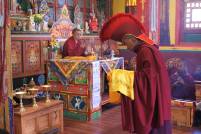History of Sherpa Buddhism
The Sherpa monasteries (Sherpa: gonpa or Nep. Gumba) of Solu-Khumbu in Nepal are home to exciting traditions, including ritual dance (cham) and calendric festivals, especially the Dumji festival in spring, the Mani Rimdu festival in October to November and unique forms of meditation and retreat (in tsam khang). They are also famous for their iconographic and architectural traditions.
While Tibetan Buddhism now comprises the schools of Gelugpa, Sakyapa, Kagyupa and Nyingmapa Buddhism, the latter is also known as the original or „old“ (ngagyur) school of Buddhism in Tibet. This school was founded on the texts of kama („transmission in an uncut line from teacher to pupil“) and terma („hidden treasures“) as well as oral traditions (songs, poems, life stories) transmitted throughout the centuries by the followers of the saint Padma Sambhava. It was him who brought Buddhism to Tibet from India in the 7th century A.D. and who is widely venerated by Nepali as well as Tibetan Buddhists as Guru Rimpoche. Sherpas, literally „the people from the east“, migrated in the first half of the 16th century from Eastern Tibet provinces of Kham Salmogang, Khatog, Serta and Minyag to the area of Solu-Khumbu now belonging to the North-Eastern part of Nepal (Oppitz 1968, Sangye Tenzin 1971, 1982[1992]).
The religious people among them have received ordination from the six highest monasteries of the Nyingmapa school in Tibet. They also brought with them the householder’s way of religion, the way of the „married lama “(ngagpa), which was widely practiced in former times in the villages apart from shamanic traditions (Funke 1969). Changing spiritual leanings have reflected on the history of the foundation of monasteries, the first ones established by married lamas, others later based on celibate monastic orders. In the villages the ritual practice of married lamas and local shamans (minung) was related to the traditional economy but in modern times has become less popular compared to celibate monastic orders (Ortner 1989).
However, the differing traditions and daily practices are still preserved in the monasteries which thus provide a rich cultural heritage to be explored by visitors. Visitors may be impressed by the subsistence economy related to current Sherpa monasteries.
Map from Oppitz, Michael 1968, Geschichte und Sozialordnung der Sherpa, indicating the migration route of the Sherpa people (“Wanderungsweg der Sherpa”) from Kham Salmogang in Eastern Tibet to Solu Khumbu (Nort-East Nepal)
Some impressions
Bibliography:
Funke, Friedrich Wilhelm 1969: Religiöses Leben der Sherpa. Innsbruck and Munich.
March, Kathryn 1979: The Intermediacy of women. Female Gender Symbolism and the Social Position of Women among Tamang and Sherpas of Highland Nepal. Cornell University.
Oppitz, Michael 1968: Geschichte und Sozialordnung der Sherpa. Innsbruck and Munich.
Ortner, Sherry B. 1989: High Religion. A cultural and Political History of Sherpa Buddhism. Princeton.
Sangye Tenzin and A.W. MacDonald 1971: Shar pa'I chos ‘byung sngon med shangs pa'i dbyu gu (History of Sherpa Buddhism). In Documents pour l’étude de las religion et de L'organisation sociale des Sherpas. Junbesi/Paris-Nanterre.
Sangye Tenzin 1982 (1992): Snowlight of Everest. Posthumously published by F.-K. Ehrhard & A.W. Macdonald. Stuttgart
